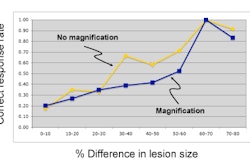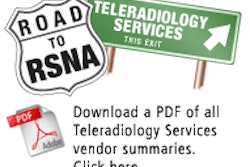The Deficit Reduction Act (DRA) is the best thing that ever happened to the PACS marketplace. There, I've said it. Now before you ask me to take a drug test, I ask only that you read this article through to the very end. Also understand that what I'm about to say is not rocket science. It's simply common sense.
When the DRA came out, nearly everyone in the market freaked out. Radiology business managers, radiologists, hospital administrators, and others who saw that revenues were going to drop put the brakes on new purchases, looking for additional ways to cut back on expenses. They also looked at ways to improve efficiency and productivity without spending any money.
And PACS? PACS was a frivolous expense that needed to be avoided at all costs. "Film works so let's keep using film," they'd say. The refrain was heard time and again: "I'm losing money here, so why would I want to spend more?"
And if someone were so bold as to consider PACS in these trying times, they would almost always go with the cheapest solution possible, even if it meant giving up a feature or benefit they either needed or wanted. In response, vendors desperate to make a sale would drop their pants price-wise without even being asked to, selling systems at or below cost. That's why so many vendors showed quarter-to-quarter sales growth, yet also exhibited lower-than-expected net profit margins.
This is all wrong. No one wins by buying on price alone, compromising functionality to save a buck. No one wins, either, when nothing is done to solve the problem. To offset lower revenue you need to reduce spending, reduce costs, or increase productivity. PACS allows you to do all three, plus it positions outpatient imaging centers or other facilities for future growth.
Even more important, PACS allows you to show financial growth in a time when most places are showing financial declines. But you have to spend money to make money.
Healthcare is not unique in this quandary. Everyone seems to be looking to cut back and save money, especially government. As I was writing this article, the front page headline of the Orlando Sentinel read "Traffic court 'disaster' brewing." The article talked about how the Florida state legislature, using a slash-and-burn mentality, decided to save $158,000 by eliminating six traffic hearing officer positions.
On the surface that sounds great until you read a little further and realize those same $26,000-a-year officers addressed cases that generated a total of $27.4 million in revenue in 2007. Now let's do the math here: We "save" $26,000, but potentially lose $4.57 million per officer. Yup, that sounds just like DRA logic to me.
The state legislators needed to cut $16.9 million from the fiscal budget so they looked at areas where they could make cuts quickly, where no one would notice. The article goes on to say that "judges ... whose dockets are already overflowing will be left to pick up the slack," and "those whose traffic-citation challenges aren't heard by a judge in a timely manner will see their tickets dismissed."
The article concludes by saying that, at best, the judges will be able to hear 25% of the cases. This still leaves more than $20 million of uncollected revenue on the table from this "cost savings." This has about as much logic as not considering PACS in these trying financial times.
Making money by spending
So how can spending money on a PACS make money? By providing improved efficiency, improved productivity, reduced costs, and increased referrals due to higher primary care physician satisfaction with the services provided.
That PACS increases productivity is a given, saving at least three minutes per procedure by not dealing with film-related issues. Fixed costs such as equipment and full-time equivalents (FTEs) all remain the same whether doing two or 20 procedures per day, so any additional revenue generated is pure profit. I will use CT in this example because CT has shown consistent growth over the past few years at 8% to 12% per year, with more than 62 million scans performed annually.
In a site that does 15 CT scans per day, saving three minutes per study equates to potentially saving 45 minutes a day. A high-volume 64-slice CT scanner can perform three studies in that time period, but for the sake of discussion and being highly conservative we'll assume our sample facility has an older CT unit that does one study every 25 minutes or so, and that we can recover only 50% of the potential time savings at best.
That translates to one additional study per day from the use of PACS. If the site can generate $300 for one additional CT procedure per day, it will generate almost $80,000 in revenue annually, or nearly $400,000 over a five-year return on investment (ROI) period -- the standard amortization period for PACS.
If you adjust the reimbursement downward and reduce the ROI period from five to three years, you'll still be looking at additional revenue of nearly $250,000, just by doing one additional CT scan per day. You can use the same basic formula to calculate additional revenue generated by increasing MR, ultrasound, or other procedures as well. You can just take the technical fee revenue multiplied by the number of additional procedures per week you will generate through time savings, multiplied by 156 (three years) or 250 (five years).
A large percentage of imaging centers are also owned by radiology groups. If the same radiologist reads that one additional CT study generated and can bill $125 in professional services for it, that adds nearly $100,000 over a three-year ROI period, or more than $150,000 over a five-year period.
Again, use the same basic formula as the above example to calculate additional revenue generated by increasing other procedures. This leaves us looking at $350,000 to $550,000 in potential technical and professional revenue generated by PACS, depending on whether you use a three- or five-year ROI period.
The film savings from using PACS isn't small either. An outpatient imaging center performing 15 CT, eight ultrasound, 10 MRI, and 20 plain-film studies per day can easily use 250 sheets of film per day at $1.70 per sheet for the dry film commonly used with digital modalities, and $1.20 per sheet for plain x-ray film. This can easily add another $100,000 in costs annually.
You then need to add another 50% for FTEs associated with the file room, jacketing, processor maintenance and chemicals, and other associated costs that aren't required with PACS. These film-related costs can add up to $150,000 per year, $450,000 over three years, and $600,000 over five years. Add to this the technical and professional fee savings and we come very close to hitting the $1 million mark over a three-year period, and exceeding $1.2 million over five years.
You can adjust these figures higher or lower based on what you feel is appropriate to your site, but the bottom line remains the bottom line. There is no way that PACS isn't well-suited for an outpatient imaging center, or frankly any other facility that can see the increased efficiencies and cost savings that this technology provides.
Contrarians will talk about service contract costs, PACS systems administrator costs, marketing costs, and a host of other "what abouts," but the savings here are so huge that you can add in whatever you want and still come out far ahead. Besides, you still will have marketing costs with or without PACS, and PACS gives you something especially exciting to market as well.
FTE costs? Valid perhaps for a large hospital setting, but then the savings are so great that the $80,000 or so spent annually on a PACS system administrator will tend to get lost in the savings. In an outpatient imaging center, the system administrator's duties are also typically shared or absorbed in the duties of the person overseeing scheduling, billing, and other clinical systems. As a result, the added work is minimal.
Why not PACS?
So why doesn't everyone clamor for PACS? The first and most important reason deals with education: Most people either don't know or don't look closely at the facts associated with a PACS purchase.
The second reason is the FUD factor: fear, uncertainty, and doubt. People fear what they don't know, which again relates back to the first reason: education.
The third reason is available capital. While most facilities don't have the hundreds of thousands or a cool million dollars lying around to spend on a PACS, almost every vendor has creative financing available.
A variety of application service provider (ASP) and fee-for-service (FFS) programs are available for those who wish to "pay as you go," plus, of course, open and closed-end leasing as well. The downside of these aforementioned programs is the more your volume increases, the more your costs increase. Frankly, though, that's a small price to pay for increased efficiency when you have no capital to spend and want to become more competitive.
You can increase volume in a competitive market via multilayered marketing. Imaging centers cater to two types of clients: referring physicians and patients. PACS allows quicker reads, the ability to create annotated image montages, the ability to send reports in near real-time, and a host of other related benefits.
Images can also be sent to a referring clinician via the Web if desired. This added value and increased service should make the difference between a center capturing the referring physician's business, especially orthopedists, internists, and other high-volume radiology service users, and watching the business being sent up the street to a competing PACS-enabled facility.
Catering to patients is fairly easy. The ability to create a CD or DVD provides a huge marketing opportunity to patients, at a cost that is less than the cup of coffee most places provide to their patients. If patients have the ability to bring a copy of their study to their referring doctor or other specialists -- not just the hard-copy report or having to deal with carrying bulky and costly films -- there is a value associated with this.
I live in Florida, and several of the imaging centers here provide patients with a CD to share with their referring physician at the time the study was created, and also provide the "snowbirds" with a copy of all the studies done at the site before they head to the now defrosted tundra they call home.
Some sites charge a token fee of $10 to $25 for these studies, while others provide these at no charge as a service to their client base. While CD burners aren't cheap, in the grand scheme of things, the cost is actually negligible when you examine the actual costs.
Let's go back to our sample site that has CT, MRI, ultrasound, and plain film, performing about 50 studies a day. An automated medical-grade CD burner that creates labels from information obtained from the RIS and has an embedded DICOM viewing software that launches upon insertion can cost anywhere from $20,000 and $50,000, depending on the features and functionality desired.
Creating 50 CDs per day (one per study) would add less than $1 per day to the overall PACS costs over a three-year ROI period (60 a day over five years). Add to that another 25¢ for media, labeling, cases, etc., and your cost again is less than the cup of java you offered the patient upon arrival.
Increase the volume of CDs created and CD burner costs decreases proportionately. Even if the CD were to cost $5 each, the cost to satisfy the referring physician, other clinicians who may want or need to see the studies, and the patient would be less than 1% of the total revenue generated -- a bargain at any price.
So is all this information new? Not at all. So why haven't people heard it? It's almost like dealing with your kids (or at least mine). They never hear you the first few times you tell them something, and only when you raise your voice a wee bit louder do they ask "Were you talking to me, Dad?" and then after finally hearing what I had to say, ending the conversation with "Well, why didn't you just say so?"
One day I'll totally go into shock and actually hear "Gee, that was a good idea, Dad," but right now I'm blissfully happy to be in my Mark Twain phase with my kids. The PACS marketplace is in the same phase, too, not really ignoring but also not learning nearly as fast as they probably should be.
Never heard of the Mark Twain phase? One of Twain's best quotes goes "When I was a boy of 14, my father was so ignorant I could hardly stand to have the old man around. But when I got to be 21, I was astonished at how much the old man had learned in seven years." Just like the PACS market, which is moving all too slowly from the adolescent years into young adulthood.
Now if you've read and understood what I've written up until now, you will be just as amazed as I am at how company executives, large and small alike, continue to use the DRA as their "dog ate my homework" excuse for poor sales or poor margins, quarter after quarter. That should not be the case. Thankfully, a few companies have shown that they know how to sell in these trying times by being creative and educating their customers on the benefits of PACS.
In the early 1700s, Voltaire said, "Each player must accept the cards life deals him or her; but once they are in hand, he or she alone must decide how to play the cards in order to win the game." Albert Einstein carried this idea a step further 250 years later by stating what I consider the obvious: "You have to learn the rules of the game. And then you have to play better than anyone else."
PACS allows you to play much better than anyone else when dealt a hand you've never seen before. DRA is the hand we've all been dealt. Now, it's time to play to win.
By Michael J. Cannavo
AuntMinnie.com contributing writer
March 27, 2008
Michael J. Cannavo is a leading PACS consultant and has authored nearly 300 articles on PACS technology in the past 16 years. He can be reached via e-mail at [email protected].
The comments and observations expressed herein do not necessarily reflect the opinions of AuntMinnie.com, nor should they be construed as an endorsement or admonishment of any particular vendor, analyst, industry consultant, or consulting group. Rather, they should be taken as the personal observations of a guy who has, by his own account, been in this industry way too long.
Related Reading
Part XVIII: Exploring PACS Secrets -- Hiding out in plain view: PACS at HIMSS, March 10, 2008
Part XVII: Exploring PACS Secrets -- The state of the PACS market, 2008, February 7, 2008
The 2007 PACSman Awards: Great expectations, November 29, 2007
Part XV: Exploring PACS Secrets -- The eHarmony approach, August 1, 2007
Copyright © 2008 AuntMinnie.com



















